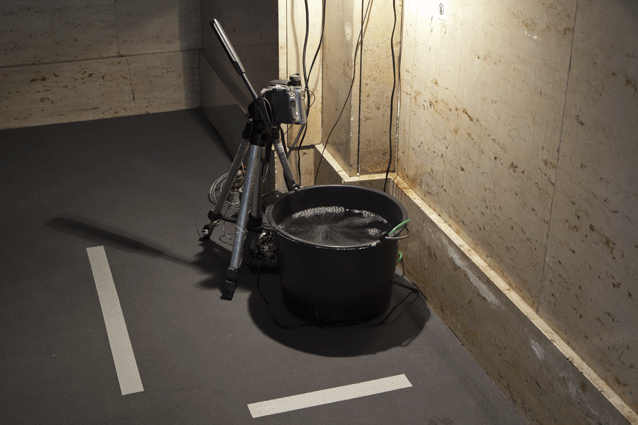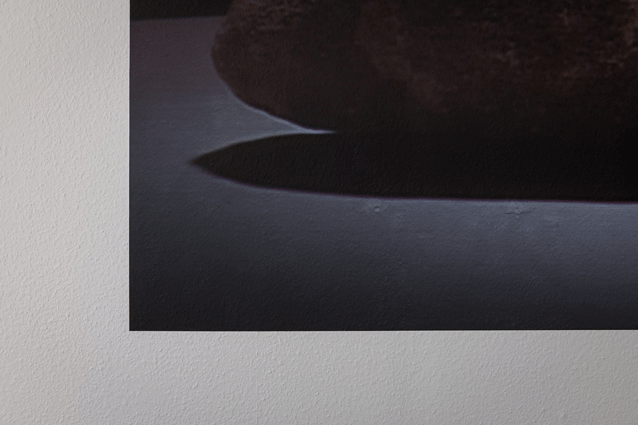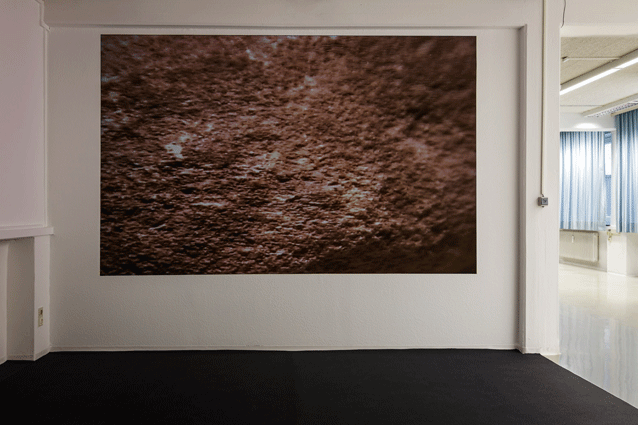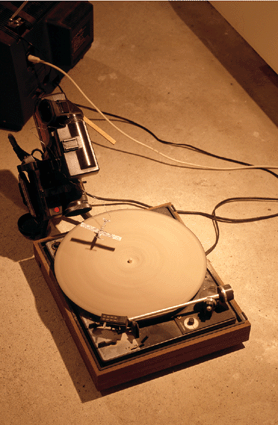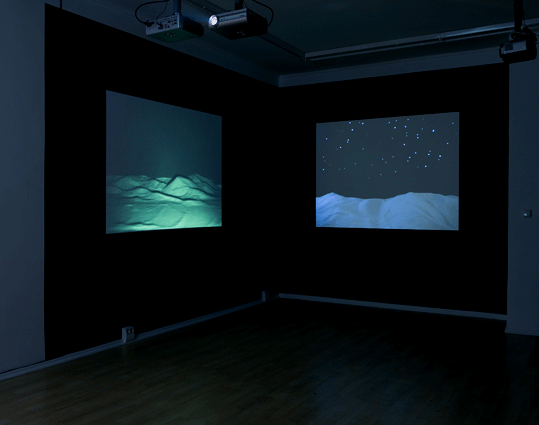Signature of Modernity – On the Art of Alexander Steig
Viewing Alexander Steig‘s videos, I am reminded of the fact that the artist studied painting and sculpture in Hanover in the 1990s. If he had stayed with painting, he might have fallen in love with Abstract Expressionism. I have to think of this style of painting when looking at his 2011 work Kryptós. It is a single-channel closed-circuit video production that Steig showed for the first time at the Kunsthaus in Luxembourg. As is so often the case in his work, cause and effect diverge in Kryptós in a striking and astonishing manner. The effect, in this case, involves video images showing tachist forms; white lineatures against a black background that change every half second. We see both still and moving images of great expressive power that capture our attention and do not let go. The underlying cause to which they owe their existence are on display in another room. We see gurgling water producing bubbles in a bucket. It is illuminated by a halogen lamp whose light refracts the restless surface of the water.

Kryptós #2.4, Haus der Kunst, MunichThe resulting images are recorded with a video camera and then transferred with the help of a projector onto a black-primed wall surface in the exhibition space that the artist has intended for this purpose. This combination of enchantment and disillusionment, of poetry and prose, is typical of Alexander Steig‘s artistic approach. And in the context of his works as a whole, even more than in the individual case of Kryptós, I am reminded of the painting of the New York School. One of its best-known protagonists was Jackson Pollock, who after a certain moment in his career no longer worked with brushes but dripped and poured paint onto the canvases lying on the floor, whereupon his friends and fellow artists gave him the allusive moniker Jack the Dripper. The result of this painting method was an all-over effect and the suspension of a perspectival spatial pictorial architecture in the classical sense. The critic and exegete of the New York School, Clement Greenberg, derived from this the normative postulate of flattish painting: ‘Make it flat!’ Painters were not to use trompe l‘oeil and eye-deceptive tricks in their pictures but rather emphasize the two-dimensional character of the canvas. Art was required to show its tools and not to fool the viewer into thinking that an X was really a U. After the moral convulsions of the twentieth century, honesty became the order of the day for art and, in a sense, the signature of modernism.
Alexander Steig is also one of this kind of enlightener in art. As such, the title of his sculpture Kryptós is doubly apt – nomen est omen – with a view to the fine word about the symbolic nature of the name. On the one hand, the scripts of the video images seem like permanently transforming calligraphies that want to be deciphered by the viewer. The ancient Greek word ‘kryptós’ means hidden or concealed. With this in mind, however, it is also important to discover the truth about the genesis of the pictures The artist allows for the possibility of this to the viewer in each of his works. Ciphering and deciphering, at least as far as their genesis is concerned, are an intrinsic part of all of them and are a matter of course for Steig. When a major exhibition currently on show in Hanover, Wolfsburg and Braunschweig under the title ‘True Pictures?’ asks about the veracity of photography, it becomes evident that they themselves may not trust their own pictures without reservation. Although the camera readily records everything that is in front of its lens, the way in which the resulting images are to be read and interpreted largely depends on their respective context. Bertolt Brecht already knew this in the 1930s when he observed: ‘A photograph of the Krupp works or the AEG tells us next to nothing about these institutions’. And today a photographer like Stan Douglas knows it, who has noted as regards photography‘s claim to truth: ‘There‘s more truth in the lie than in the documentary’.

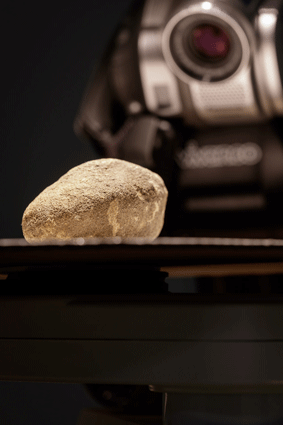
Leinekiesel - Set, feinkunst, HannoverThe video production Leinekiesel (2021) in the spaces of feinkunst e.V. in Hanover also plays with the difference between the cause and effect of the image. Steig demonstrates this in four cabinets. Depending on the order in which you visit them, you are led either from cause to effect or vice versa from effect to cause. Let us start with the installation dispositif, that is in principle with the sobering or prosaic aspect in the work of the visual magician Steig! On a round, white cardboard disc we see a palm-sized pebble surrounded by four cameras pointed at it. They each focus on the pebble from different perspectives, which naturally means that they each show a different side of it. If the viewers look at the images of the
stone produced in this way without knowing this dispositif, the situation is by no means clear and unambiguous to them. In his media production, Steig poses the question of perception in an exceedingly light-handed manner. What do we actually see when we see something? And he also poses anew the question of identity with which the poet Arthur Rimbaud confronted us in the late 19th century: In the word of his famed self finding: ‘Je est un autre’ (I is someone else). The fact that Steig uses a pebble that he found in the bed of Hanover‘s local river Leine is to be understood as a homage to his native city. The artist already staged a similar production in 2020 with a pebble from the Isar River in honour of Munich, the city that has long since become his adopted hometown.
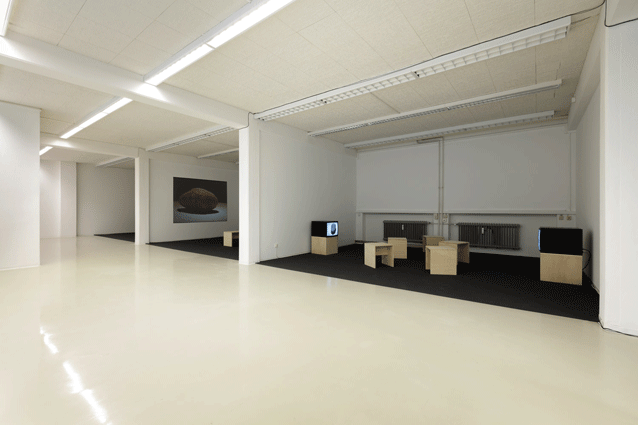
Leinekiesel - Findling (Erratic Block) #1.2, feinkunst, HanoverAt the Munich exhibition, Steig presented the Isar pebble on two adjacent monitor projections. Filmed from two different angles, different sides of the same pebble were shown, which, however, could not be recognised as such by viewers without knowledge of the dispositif. In these cases, perception theory speaks of numerical identity, whereas in the case of two similar but different objects, it speaks of qualitative identity. Steig has addressed and demonstrated both forms of identity in various works. One can also speak of numerical identity in all forms that the Leine pebble was presented. At feinkunst, the pebble came closest to the Isar pebble when it is shown in a space on two monitors positioned opposite each other. In both images, the brightly illuminated pebble lies on a white ground in which, equipped with the corresponding knowledge, we recognise the installation‘s white cardboard disc. And therefore we assume that the two stones, which look similar to each other, are one and the same pebble, and that we can therefore look at them from the point of view of numerical identity. If we do not know this, we will assume that the pebbles in the two pictures are similar but different because of the different perspectives, i.e. we will assume a qualitative identity between them.

Leinekiesel - Leinekiesel (numerisch), feinkunst, HanoverThe stone recedes far away from the original impression it makes on us during its demonstration in the installation dispositif in two of the house‘s other rooms. This is already due to the discrepancy in size between the real pebble and its representation in the projections. The most extreme example is in the last room. The video camera is brought very close to the pebble with a wide angle. The laser beamer projects its image, or rather the part of its surface on which the camera concentrates in its zoom shot, exactly onto the wall. The artist has painted a large rectangular surface black at this point for the projection. Just like in the Renaissance, when painters worked on darkly primed canvases, it determines the picture temperature. Depending on the position of the viewer, the colours, influenced by the laser light, shimmer there. What we see is a strange and alien landscape, as remote from us as the surface of the moon. One is reminded of Karl Kraus and his linguistic bon mot: ‚The closer you look at a word, the further away it looks back at you‘.

Leinekiesel - Wand (Wall), feinkunst, Hanover, 2021The projection in the neighbouring room is similarly painterly, albeit far less exotic or futuristic. There, too, Alexander Steig has prepared a black projection surface for the image of the pebble. It forms a dark backdrop, against which the stone, which lies in naturalistic splendour on a grey surface, appears. Behind it, once again, is the white cardboard disc of the installation, which the black ground alienates accordingly. The recording appears painterly in the classical manner. One is left with the impression of a successful alliance between abstract and representational art, as if monochrome colour field painting and differentiated realism had found their way to becoming a unified entity in it. What manifests itself here is rather that which some visitors feel in the face of this installation: meditative calm and agreeable deceleration.
This impression could be supplemented. It is important to remember what viewers could easily overlook if they take only a cursory glance at Steig‘s installation. The disc on which the stone rests rotates very slowly, in fact almost imperceptibly. It takes 24 hours to rotate once around its own axis. This is the same time span to which the Scottish video artist Douglas Gordon stretched Alfred Hitchcock‘s film ‘Psycho’. He slowed down John Ford‘s film ‘The Searchers’ even longer, namely to the duration of the film‘s plot, five years. Twenty-four hours, that is one day and one night, the amount of time it takes the earth to rotate around itself once on its orbit around the sun. It is a mythical unit of time. The action of James Joyce‘s iconic novel ‘Ulysses’ unfolds over the course of 24 hours. In terms of its extreme deceleration, the movement of the disc also recalls a state of modernity described by the French dromologist Paul Virilio ‚frenetic standstill‘ to characterise the entropic end-stage of a period of constant acceleration. Steig‘s work evokes numerous references. By introducing time into his installation through the movement of the disc, he draws attention to its expansion. It is precisely the slowing down that makes us forget the normal rhythm of time and leads to its extreme lengthening that makes its character so clear to us in the first place. We are made acutely aware of what we otherwise hardly perceive, namely that time as such is endless and boundless, but things have their time within it. Just like ourselves. In view of eternity, our lives last only a blink of an eye. Seen from this perspective, Steig‘s installation can be understood as a modern memento mori.
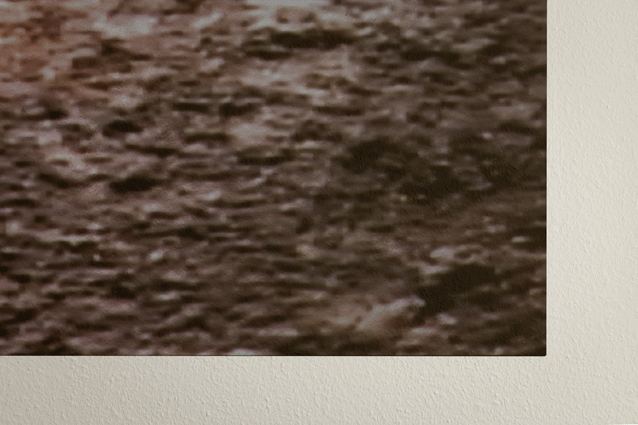
It is also necessary to discuss the ‚poor materials‘ involved in the making of this installation. A cardboard disc and a pebble, a simple rotating mechanism, a lamp with strong light, four cameras, two monitors, two beamers. Voilà tout. If Alexander Steig, who was only born around that time, had been active in the 1960s, he could have exhibited together with Alighiero Boetti, Luciano Fabro, Jannis Kounellis, Giulio Paolini, Pino Pascali and Emilio Prini. At a show organised in his home town of Genoa on 27 September 1967 by the critic and curator Germano Celant, the works of these artists were first described as ‚Arte Povera‘ because they made their art with poor, i.e. everyday and ordinary materials. What closed circuit installations has Alexander Steig not conjured up from such poor materials in the past! In his 1999 piece Über-Wachen, he even managed almost completely without any aids. At the same time, he did not shy away from slapstick, for humour, alongside humane commitment, plays no small role in his art. In the dark crypt of a mausoleum in a Hanover cemetery, he installed solely a video camera and a light source. The camera transmitted the image of the empty tomb in real time to a monitor that stood above it on an urn table. Unfortunately, as we hear, there was no visit from the afterlife to record in this very special form of surveillance.

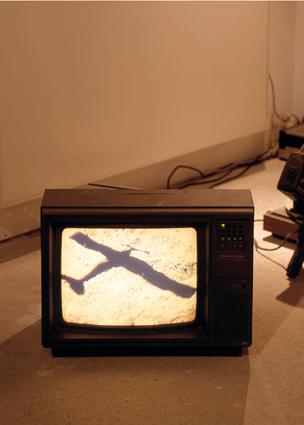
Flying, Eine Deutsche Einkaufspassage, Hanover, 2000In 2000, Alexander Steig poetically celebrated the turn of the century in the skies with minimal means. In flying, a rotating turntable covered with dust and the paper silhouette of an aeroplane above it were enough to simulate his flight over the expanses of a sandy desert. Later, at the Kunsthalle Worpswede, he went to the cold north. In order to walk on floating icebergs under a starry nocturnal sky in Heimliche Landschaften (2010), he used lamps and cardboard boxes with holes and gashes in them. The video camera took care of the rest. In Luxembourg, a few drawn lines on window panes and footage of a villa across the street were sufficient for him to create a portrait of a building he titled Haunted House #3 (2010).
In Poznan in 2012, his camera made enormous dunes grow out of tiny clusters of sand in his work Sceneries (Landscapes in Repose). And in À l'ombre (2014), Steig staged the prototypical drama of a voyeur in Brussels from the video transmission of a keyhole, involving the viewers. He always operates like a director who writes his own plays. But at the same time, by allowing us to look at his cards, he evokes the memory of the young Brecht. When he performed his first epic play in Munich in 1922, the playwright had the words ‘Don’t gawp so romantically’ written on the walls. The audience should think along, not just feel along.
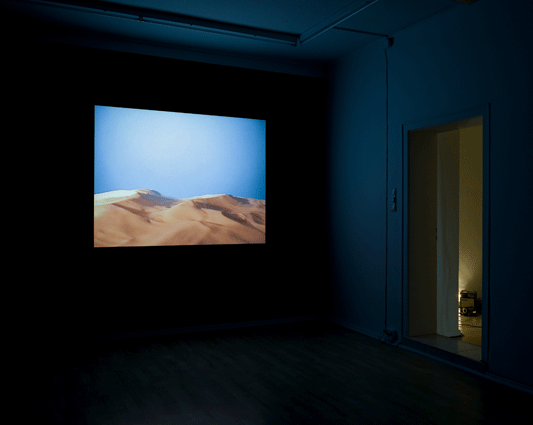
Sceneries - Landscapes in Repose, Gallery k4, Munich, 2007Alexander Steig amazes us with his art. In doing so, he follows Sergei Diaghilev‘s challenge to Jean Cocteau: ‘Etonne-moi!’ At the same time, however, he also follows the ethical rigorism of a Clement Greenberg or Bertolt Brecht, who pleaded for honesty in art and for a philanthropic humanism. All this can be seen in the fact that Alexander Steig not only consistently makes the instruments and scenarios of his art visible to the members of the audience but also how he takes them along and lets them participate in his philosophical and analytical delight in thinking, in transformation and charade. One not only watches oneself seeing in his works – Visus Visere (2011), seeing seeing, was the name of an exemplary video installation conceived in the past by Steig for Kunstraum München – and analyses one‘s perception, but also loves this activity.
A symposium he initiated was dedicated to the pause and thus to creative idleness. Nothing could be more important for artists – and not only for them – to come up with new ideas. Marcel Duchamp once gave the beautiful answer to the question of what he was working on: ‘Je respire’. I breathe. The humanism in Alexander Steig‘s art is also evident in projects in which he has made the past his subject. An example of this is his research into forced labour in the Munich-Giesing subcamp of the Dachau concentration camp Agfa-Kamerawerk. For the victims, he created an impressive sign of remembrance with the large black camera as a memorial.
Michael StoeberTranslation: Michael Wolfson, Hannover/Berlin
(Catalogue: Alexander Steig - Leinkiesel)
